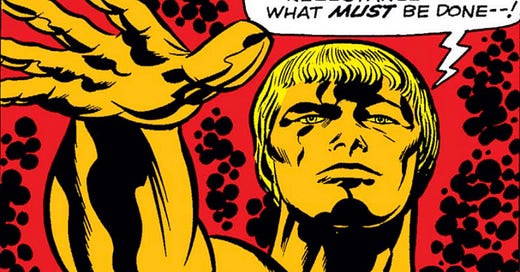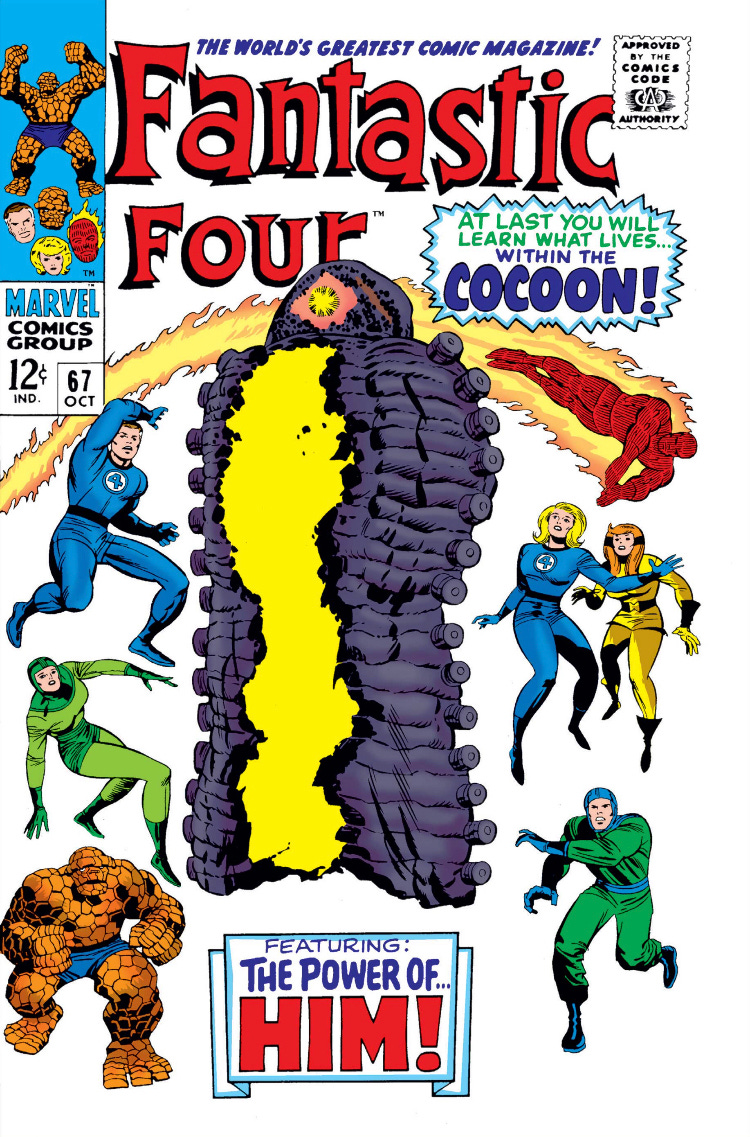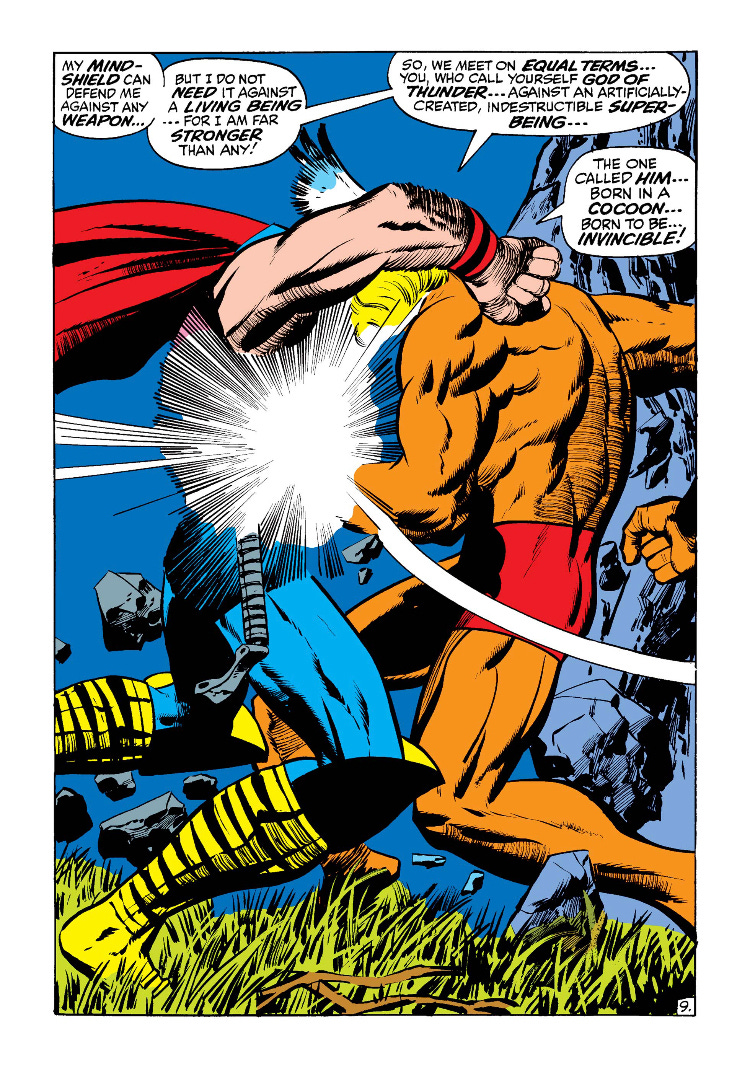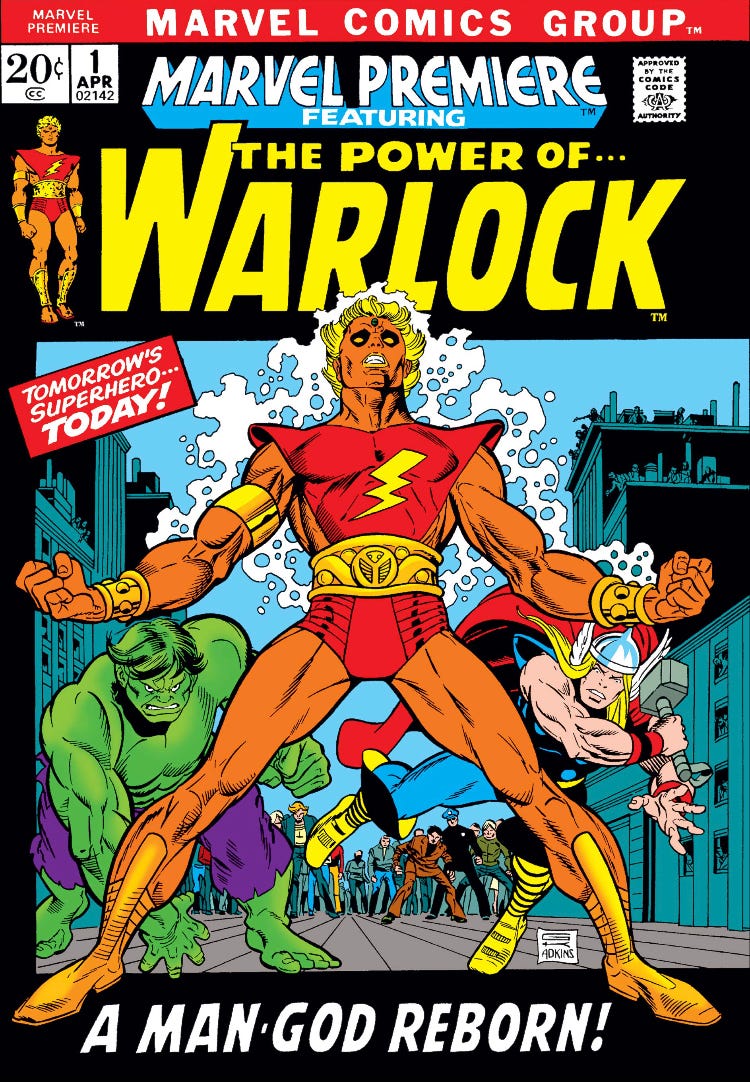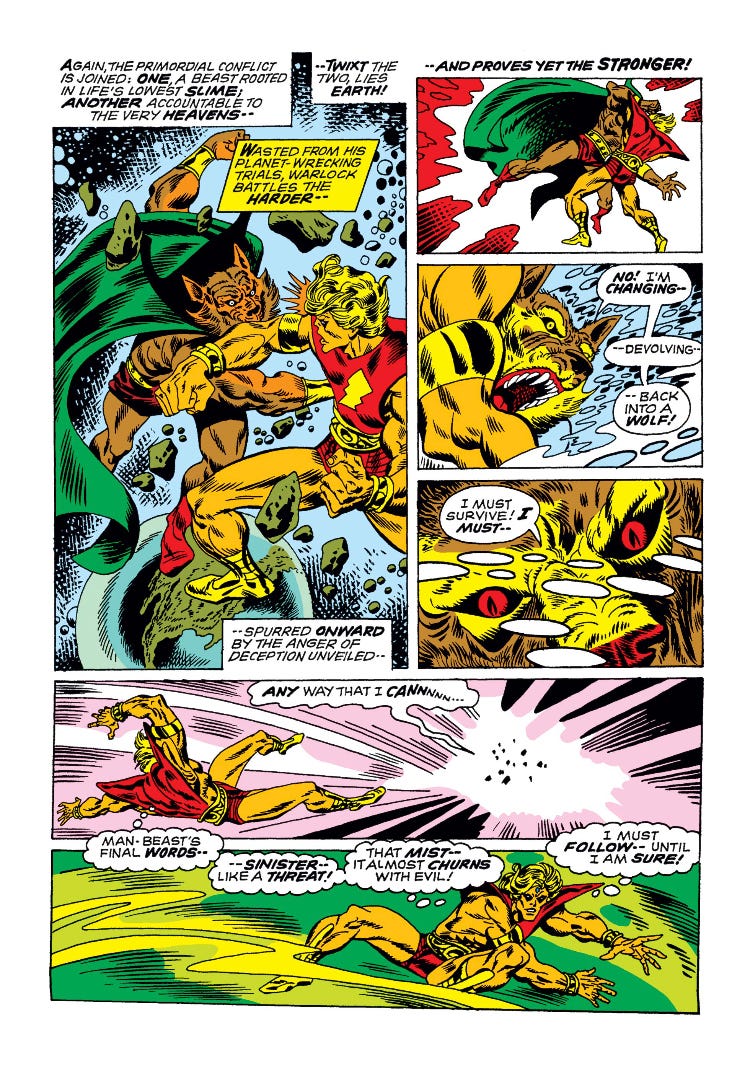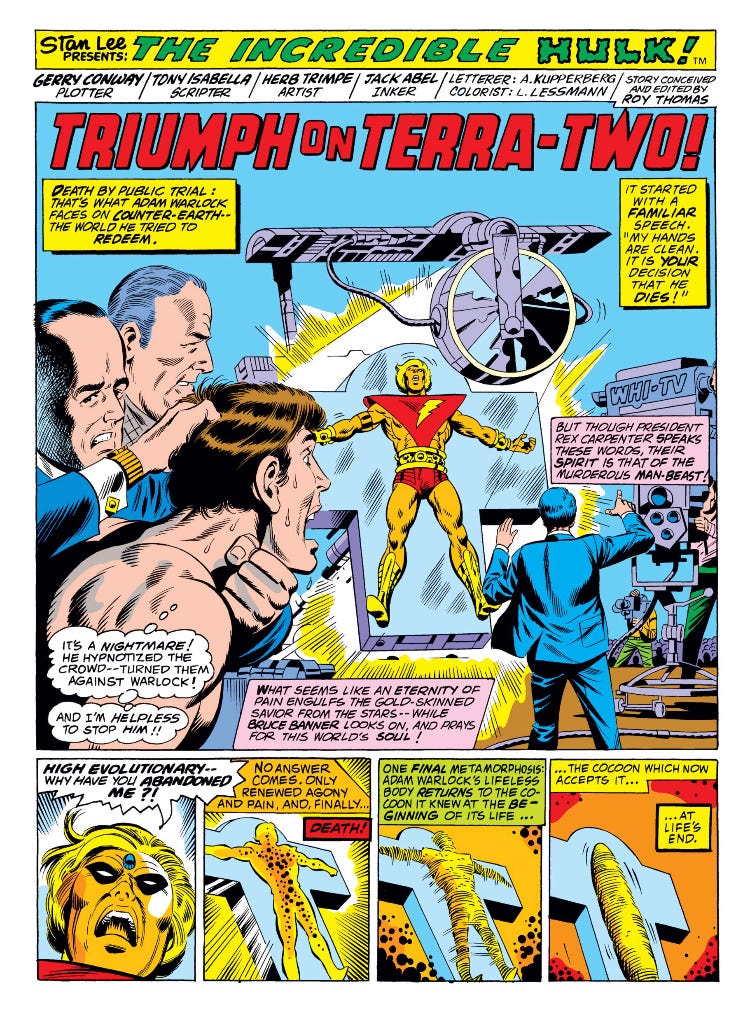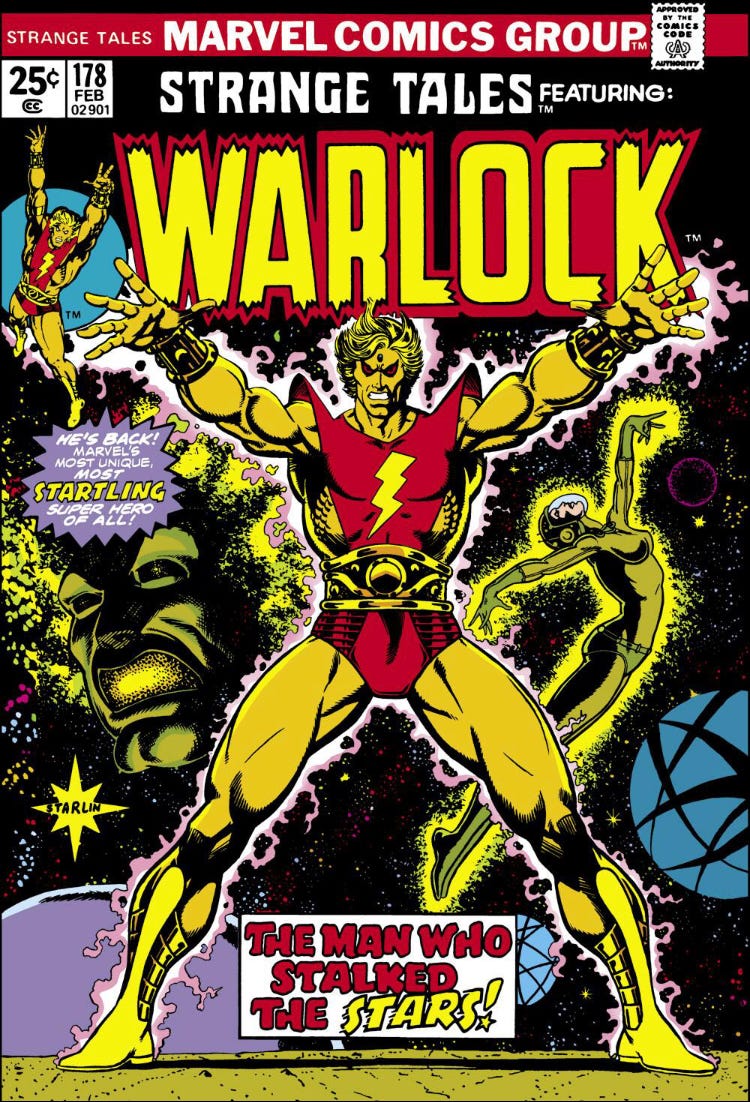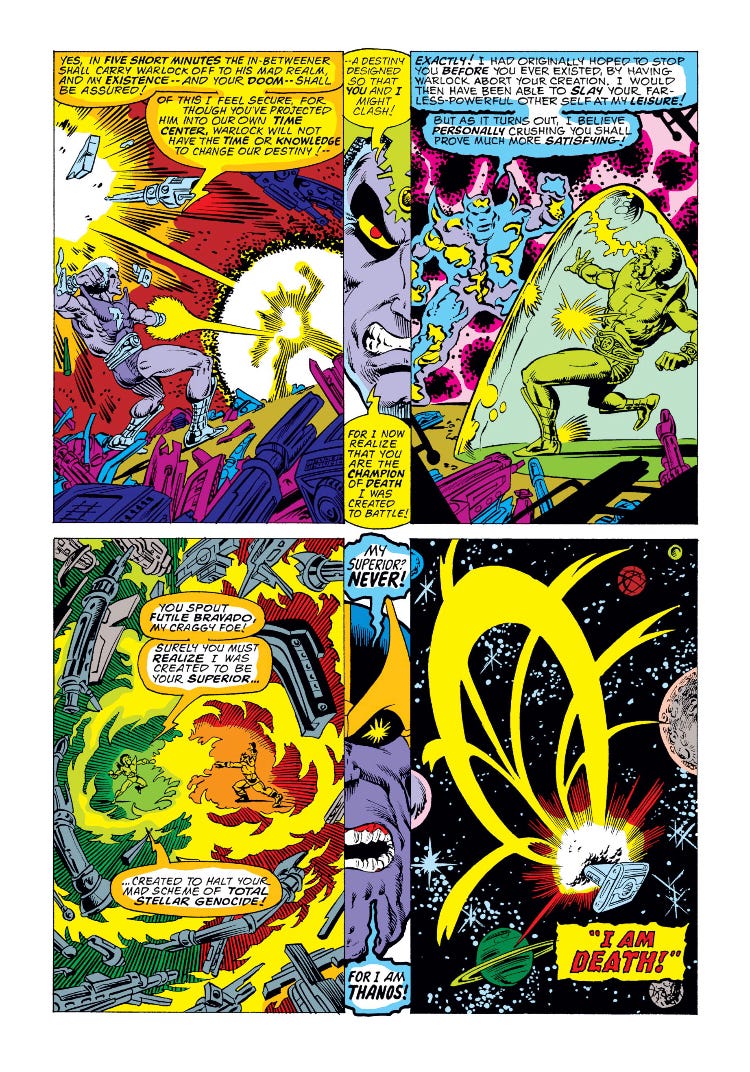
Adam Warlock is set to make his big screen debut this weekend (as played by Will Poulter) in Guardians of the Galaxy Vol. 3. Warlock is a paradoxical character in Marvel Comics. He is simultaneously both an obscure character and someone who has headlined multiple major event comics. His origins stem from Stan Lee and Jack Kirby’s legendary Fantastic Four run in the 1960s, yet he is most closely associated with the psychedelic weirdness of Bronze Age Marvel in the 1970s. He has represented everything from criticism of eugenics to exploration of Freudian psychology to being Space Jesus for an artificially created Earth. The man contains multitudes. Let’s take a look at how this character went from Nietzschean Übermensch to cosmic messiah.
Him: The Early Years
The character that would become known as Adam Warlock was introduced by Stan Lee and Jack Kirby in Fantastic Four #66-67 in 1967. This two-part story is about a group of world renowned scientists who are determined to solve all of society’s ills by creating a race of perfect human beings (that they would control). They seemingly succeed, but the being they’ve created is so radiant that they can’t look at it. Determined to know what their creation looks like, the scientists abduct Alicia Masters (the blind artist) to touch their creation’s face and sculpt it for them. Alicia also happens to be Ben Grimm’s girlfriend, so that’s why the Fantastic Four get involved. Alicia ultimately learns that this being, referred to only as Him, is in a cocoon and preparing to be reborn into the world in his true form.
When the being finally emerges from his cocoon, he’s revealed to be a man with golden skin and hair. He uses his unspecified powers to generate enough energy to fly off into space and kill his creators in the process.
The next time we see Him is in the pages of Thor #165-166, also from Stan Lee and Jack Kirby. The plot of these two issues is about Thor and the Asgardians investigating a strange energy source which just so happens to be Him inside of another cocoon. He emerges from his cocoon just as the Asgardians arrive and generously provides an exposition dump for anyone who didn’t read his previous Fantastic Four story. Once story time is over, he decides to take Sif as a mate and kidnaps her. Not cool. Thor tracks Him down, and the two engage in some epic Kirby fisticuffs. Thor prevails, and Him once more envelops himself in a cocoon to drift off into space.
Adam Warlock: Messiah of Counter-Earth
The next time we see Him is in the pages of Marvel Premiere #1 by Roy Thomas and Gil Kane which was published in 1972. The comic kicks off with the High Evolutionary coming across Him’s cocoon floating through space. Great. Another eugenicist with dreams of creating a perfect race that he can control. The High Evolutionary initially views Him as a potential ally to assist him with destroying his own creation that has rebelled against him: the Man-Beast (a sentient animal-human hybrid). If there’s one thing the High Evolutionary loves, it’s making animal-human hybrids. The High Evolutionary essentially adopts Him as his own perfect son who could save humanity on Counter-Earth by dispatching the Man-Beast. Sounds familiar for some reason. I should probably explain what Counter-Earth is as well. Counter-Earth is an artificial planet created by the High Evolutionary using the Infinity Gems so that he could conduct experiments on humans using rapid progression of time and evolution. Very normal stuff. Anyway, the High Evolutionary embeds the Soul Gem in Him’s forehead and sends him down to Counter-Earth to save its denizens.
Once there, Him loses all memory of himself and his mission. He ends up adopting the name Adam Warlock courtesy of one of the human teenagers he meets upon his arrival. He is quickly attacked by one of Man-Beast’s followers, and he regains his memories during the ensuing fight. Fortunately, he decides to keep his new moniker, so I can finally stop referring to him as Him.
After two issues in Marvel Premiere, Warlock’s story continues in his very own solo series titled Warlock with the same creative team of Thomas and Kane. The initial arc that began in Marvel Premiere essentially ends after the first two issues of Warlock, and new creative teams would cycle in and out of the series for various stories following Warlock in his crusade against Man-Beast on Counter-Earth. That crusade would eventually end in the pages of Incredible Hulk #176-178 by Gerry Conway and Herb Trimpe. During these issues, Warlock is captured by Man-Beast and sentenced to death during a shoe trial. Warlock is executed while on a cross-like platform as he calls out to the High Evolutionary asking why he had been forsaken by him. I wasn’t kidding about the Space Jesus thing.
Warlock once again goes into a cocoon following his death. After a few days inside his cocoon, Warlock emerges alive and well with more power than ever before. Warlock then changes Man-Beast back into a simple wolf with his newfound powers. With Man-Beast defeated and Counter-Earth saved, Warlock flies off into space to seek others to help. It is implied that Warlock would become known as the savior of the planet and held in almost religious esteem.
Enter: Jim Starlin
The next time we see Adam Warlock is in Strange Tales #178 written and illustrated by Jim Starlin and published in 1974. This new story sees Warlock crossing paths with the fanatical adherents of an intergalactic religion known as the Universal Church of Truth and its leader/deity, the Magus. The Magus is soon revealed to be a corrupted version of Warlock from the future who was driven mad by the Soul Gem. Warlock allies himself with Gamora and Pip the Troll to help defeat the Magus. The Magus makes short work of our trio of heroes in some truly outlandish psychedelic action courtesy of Starlin that picks back up in the pages of Warlock #9. Having been totally outclassed by the Magus, our heroes get some desperately needed reinforcements when Thanos himself joins them. From this point forward, Warlock becomes the series in which Starlin is truly given free reign to indulge in his penchant for high-minded science fiction and psychedelic imagery.
Starlin uses Adam Warlock as his point of view character to explore the metaphysical aspects of the Marvel Universe and flesh out its cosmology that hadn’t really been explored in detail since Lee and Kirby had created it in the 1960s. Godlike beings such as the In-Betweener would regularly appear, and Warlock and his companions would frequently venture inside the Soul Gem into a reality known as Soulworld. While Warlock #15 would be the last issue of his solo series, Starlin would continue to write the character in other series. He would frequently appear in stories that included Thanos, Gamora, and Pip. This would culminate in the six issue 1991 event comic known as Infinity Gauntlet. This series would go on to serve as the primary inspiration for the Avengers: Infinity War and Avengers: Endgame films that have combined to gross almost $4.9B dollars at the global box office. The basic plot details are well known at this point. Thanos collects the Infinity Gems and fuses them to his gauntlet, making him a nigh omnipotent god. Using his newfound godhood, he exterminates half of all life in the universe to impress the female representation of Death itself in hopes that she will become his bride (Thanos is a simp). Failing to impress her, Thanos ends up going to war with all of the most powerful deities in the cosmos (including Death) and wins. The victory is short lived as the gauntlet is wrestled away from him and all of the remaining heroes and villains scramble to try and secure it. Ultimately it is Warlock who gains possession of it (along with the godlike powers it bestows), and he undos what Thanos had done.
It’s arguably Warlock’s most iconic moment. Starlin would go on to write two sequels to Infinity Gauntlet (Infinity War and Infinity Crusade) with Warlock once again serving as the primary protagonist. Infinity War sees the Magus return as the primary antagonist while Infinity Crusade introduces a new villain (the Goddess) who turns out to be the spiritual side of Warlock manifested as a sentient being.
While Warlock would make occasional appearances in comics throughout the 2000s and 2010s, he very rarely served as a primary protagonist in these comics. For comics where Warlock played a central role during this time, you would need to read the various limited series and original graphic novels written by Jim Starlin. These include Thanos (2003), Thanos: The Infinity Revelation (2014), Thanos: The Infinity Relativity (2015), Thanos: The Infinity Finale (2016) with art by Ron Lim, Thanos: The Infinity Siblings (2018) with art by Alan Davis, Thanos: The Infinity Conflict (2018) with art again by Alan Davis, and Thanos: The Infinity Ending (2019) with art again provided by Alan Davis.
Warlock is ultimately a blank canvas that creators have used throughout the years to project interesting ideas and concepts onto that they would otherwise be unable to articulate using more established characters. It’ll be interesting to see what James Gunn hopes to paint on that canvas.

